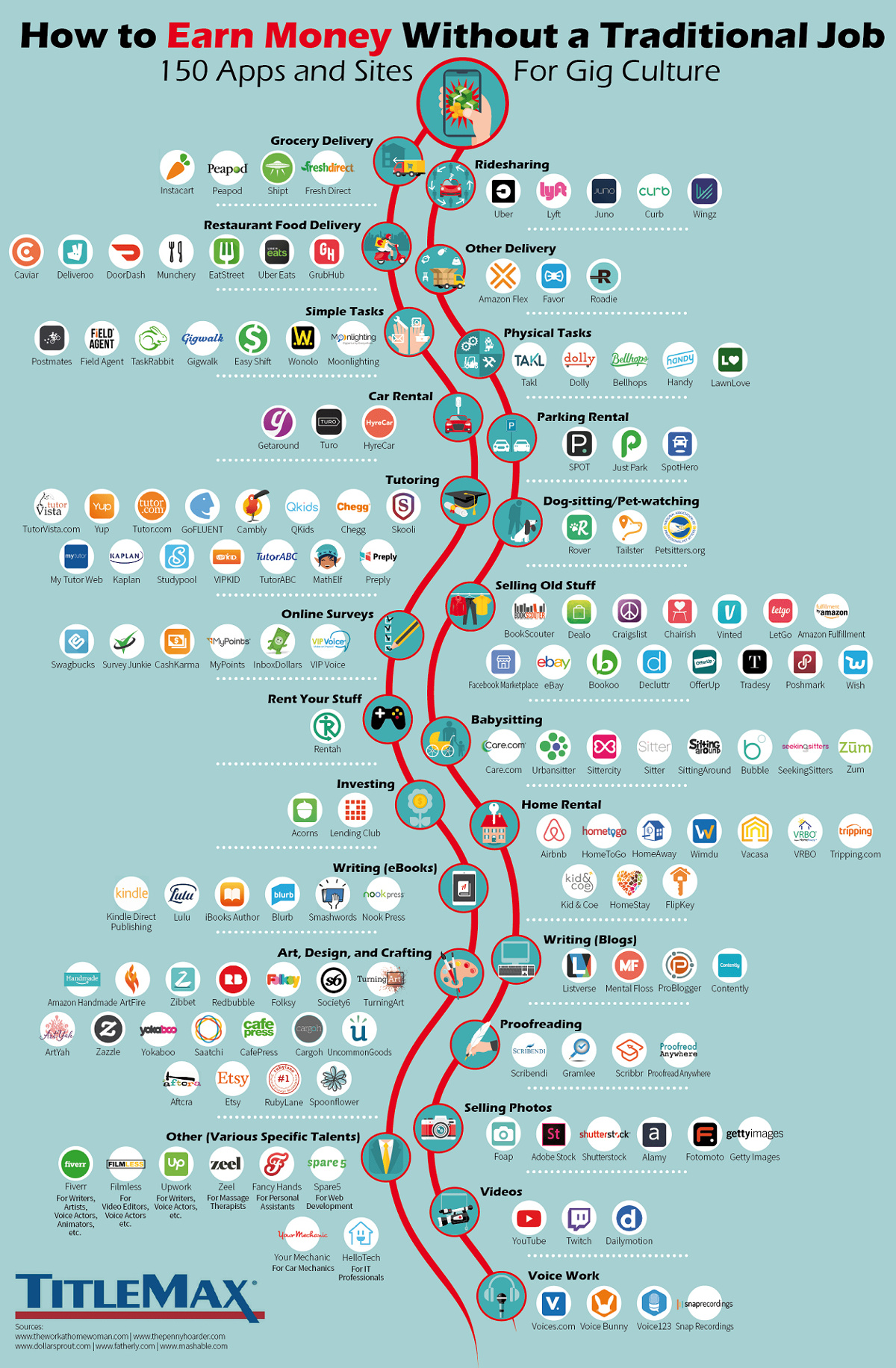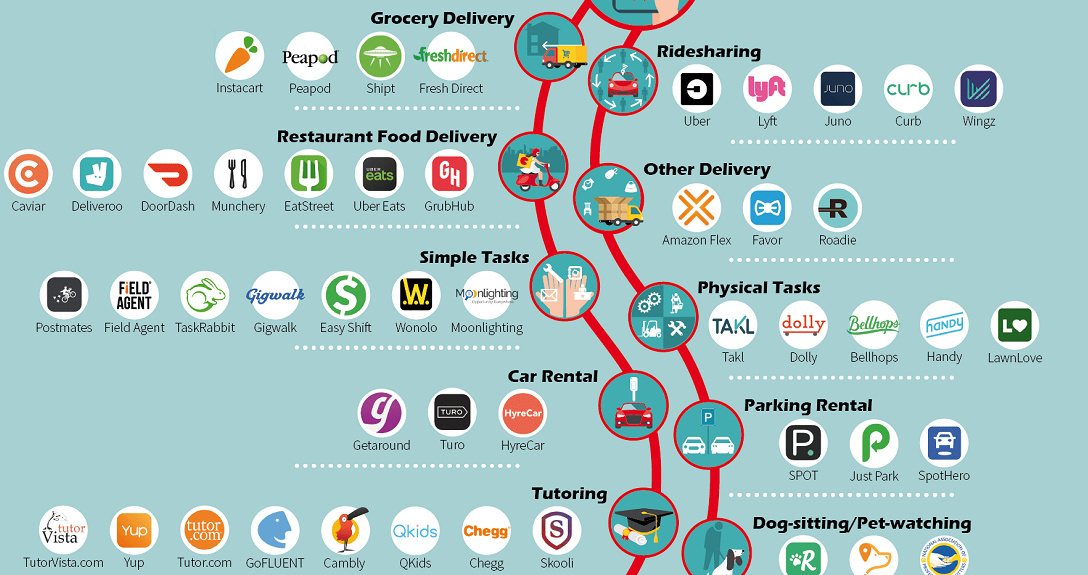Technology
The 150 Apps that Power the Gig Economy

Here are 150 Apps that Power the Gig Economy
Go back in time a decade, and you’d have a tough time convincing anyone that they would be “employed” through an app on their phone.
And yet, in a short period of time, the emergence of the smartphone has enabled the gig economy to flourish into a multi-trillion dollar global market. And by leveraging apps like Uber, Airbnb, and Etsy, it’s estimated that 57 million people in the U.S. now participate in the gig economy each year in some shape or form.
What apps do these people use to turn their time, skills, hobbies, or assets (cars, home, parking spaces, etc.) into additional income streams?
App Examples
Today’s infographic comes to us from TitleMax, and it lists 150 different apps that are used within the gig economy – including many that pay gig workers directly.
Here are just some of the apps that are used in some of the major categories above:
Ridesharing
Uber and Lyft are what many think of when they hear about the gig economy. However, there are now dozens of rideshare apps out there to fill different niches – for example, Wingz offers flat-fee rides to the airport, while Curb connects riders with professional taxi drivers.
Errands
TaskRabbit, which was bought by IKEA, turns errands such as assembling furniture or cleaning a gutter into payable gigs. Meanwhile, apps like Dolly and Bellhops will connect you with movers, and LawnLove is for lawn care.
Art, Design, and Crafting
Etsy, a marketplace for handmade goods, is one the of the best known brands in this category. However, there are many other niche options here as well – for example, UncommonGoods specializes in unique gifts, while Society6 focuses on gallery quality art prints.
Writing and Editing
Lulu and Kindle Direct allow you to publish eBooks online and sell them, while proofreaders and editors can get paid for their copy editing services through Gramlee.
Delivery
Fast and efficient delivery services are a centerpiece to the gig economy, and there are no shortage of options here. DoorDash, UberEats, Caviar, and GrubHub allow users to get food delivered to their doors, while apps like Instacart focus on grocery delivery.
Multimedia
We all know that you can create videos and monetize them on places like YouTube or Twitch, but did you know you can be a voice actor through services like VoiceBunny? You can also sell rights to your photos via Foap, or do freelancing work through Upwork or Fiverr.
Whether you are tapping into the gig economy for an extra income stream or you are incorporating gig economy services into your life for added convenience, there is no shortage of options to choose from.
Technology
Visualizing AI Patents by Country
See which countries have been granted the most AI patents each year, from 2012 to 2022.

Visualizing AI Patents by Country
This was originally posted on our Voronoi app. Download the app for free on iOS or Android and discover incredible data-driven charts from a variety of trusted sources.
This infographic shows the number of AI-related patents granted each year from 2010 to 2022 (latest data available). These figures come from the Center for Security and Emerging Technology (CSET), accessed via Stanford University’s 2024 AI Index Report.
From this data, we can see that China first overtook the U.S. in 2013. Since then, the country has seen enormous growth in the number of AI patents granted each year.
| Year | China | EU and UK | U.S. | RoW | Global Total |
|---|---|---|---|---|---|
| 2010 | 307 | 137 | 984 | 571 | 1,999 |
| 2011 | 516 | 129 | 980 | 581 | 2,206 |
| 2012 | 926 | 112 | 950 | 660 | 2,648 |
| 2013 | 1,035 | 91 | 970 | 627 | 2,723 |
| 2014 | 1,278 | 97 | 1,078 | 667 | 3,120 |
| 2015 | 1,721 | 110 | 1,135 | 539 | 3,505 |
| 2016 | 1,621 | 128 | 1,298 | 714 | 3,761 |
| 2017 | 2,428 | 144 | 1,489 | 1,075 | 5,136 |
| 2018 | 4,741 | 155 | 1,674 | 1,574 | 8,144 |
| 2019 | 9,530 | 322 | 3,211 | 2,720 | 15,783 |
| 2020 | 13,071 | 406 | 5,441 | 4,455 | 23,373 |
| 2021 | 21,907 | 623 | 8,219 | 7,519 | 38,268 |
| 2022 | 35,315 | 1,173 | 12,077 | 13,699 | 62,264 |
In 2022, China was granted more patents than every other country combined.
While this suggests that the country is very active in researching the field of artificial intelligence, it doesn’t necessarily mean that China is the farthest in terms of capability.
Key Facts About AI Patents
According to CSET, AI patents relate to mathematical relationships and algorithms, which are considered abstract ideas under patent law. They can also have different meaning, depending on where they are filed.
In the U.S., AI patenting is concentrated amongst large companies including IBM, Microsoft, and Google. On the other hand, AI patenting in China is more distributed across government organizations, universities, and tech firms (e.g. Tencent).
In terms of focus area, China’s patents are typically related to computer vision, a field of AI that enables computers and systems to interpret visual data and inputs. Meanwhile America’s efforts are more evenly distributed across research fields.
Learn More About AI From Visual Capitalist
If you want to see more data visualizations on artificial intelligence, check out this graphic that shows which job departments will be impacted by AI the most.
-

 Markets1 week ago
Markets1 week agoU.S. Debt Interest Payments Reach $1 Trillion
-

 Business2 weeks ago
Business2 weeks agoCharted: Big Four Market Share by S&P 500 Audits
-

 Real Estate2 weeks ago
Real Estate2 weeks agoRanked: The Most Valuable Housing Markets in America
-

 Money2 weeks ago
Money2 weeks agoWhich States Have the Highest Minimum Wage in America?
-

 AI2 weeks ago
AI2 weeks agoRanked: Semiconductor Companies by Industry Revenue Share
-

 Markets2 weeks ago
Markets2 weeks agoRanked: The World’s Top Flight Routes, by Revenue
-

 Demographics2 weeks ago
Demographics2 weeks agoPopulation Projections: The World’s 6 Largest Countries in 2075
-

 Markets2 weeks ago
Markets2 weeks agoThe Top 10 States by Real GDP Growth in 2023















